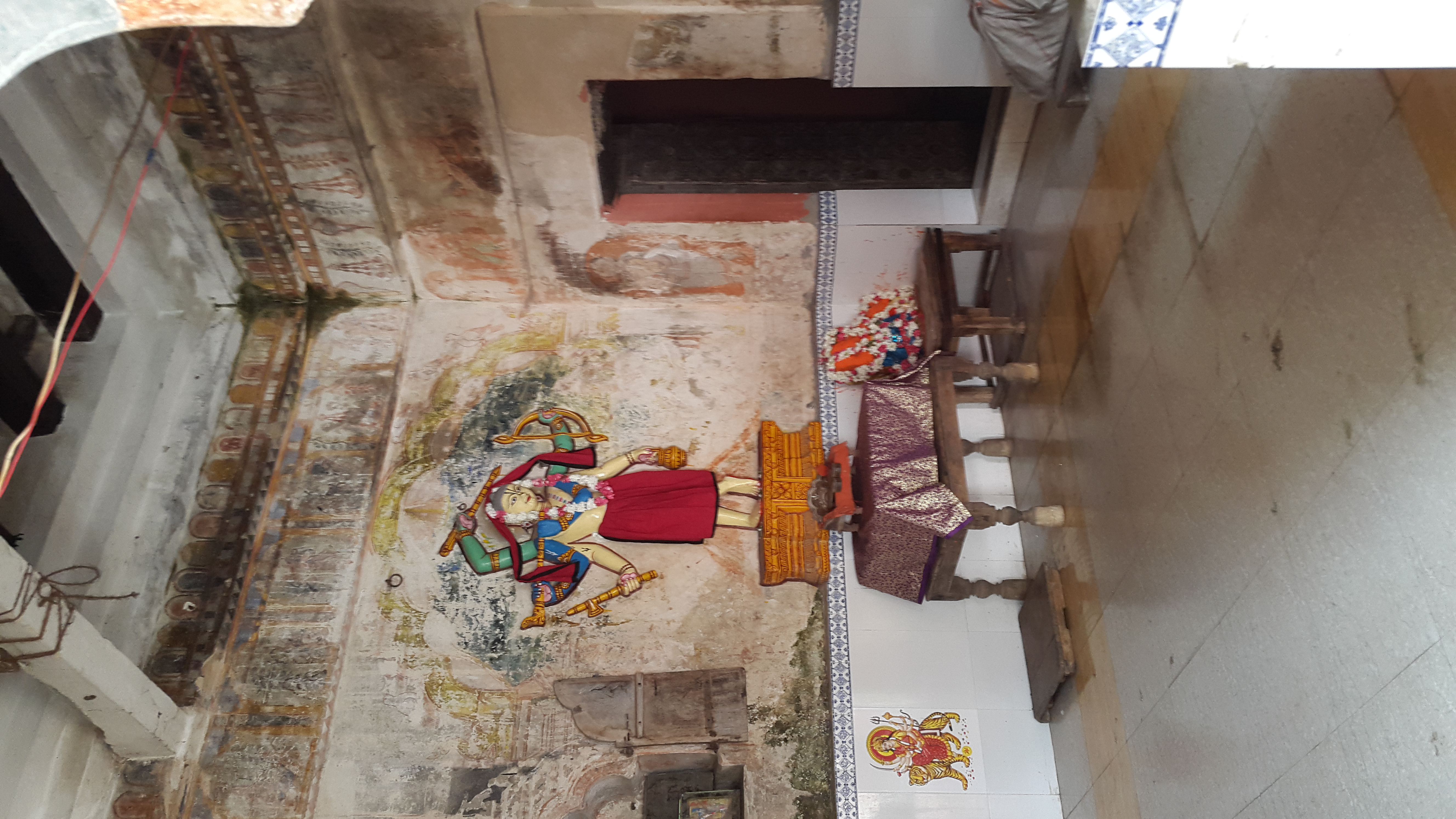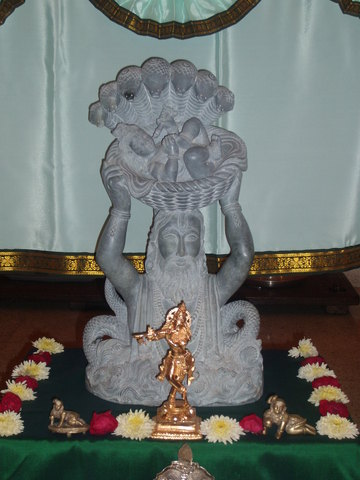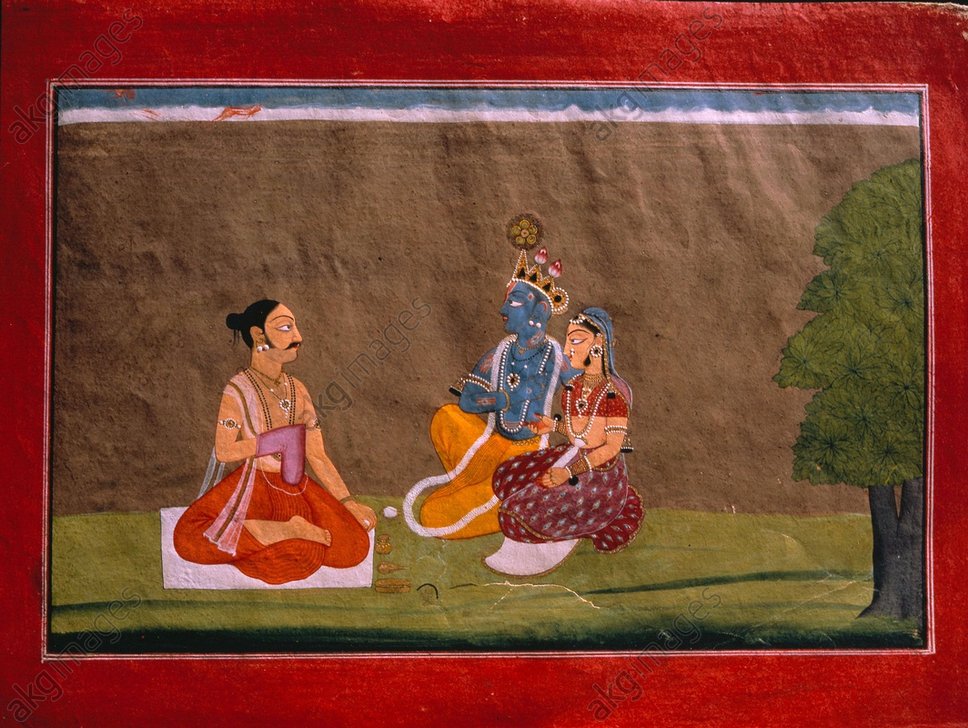|
Radha Rani Temple
Shri Radha Rani Temple, also called Shriji (Shreeji) Temple and Shri Laadli Lal Temple, is a Hindu temple, located in Barsana in Mathura district, Uttar Pradesh, India. The temple is dedicated to the goddess Radha. Barsana is believed to be her birthplace. The main deities of the temple are called Shri Laadli Lal (means beloved daughter and son), another name of Radha Krishna respectively. The temple is stretched on the top of Bhanugarh hills, which is about 250 meters in height. The temple attracts huge crowd of devotees and tourists visiting temple from across the world for its most popular festivals - Radhashtami and Lathmar Holi. History Radha Rani Temple is originally believed to be established by King Vajranabh (great-grandson of Krishna) around 5000 years ago. The temple is said to be in ruins; the icons were rediscovered by Narayan Bhatt (a disciple of Chaitanya Mahaprabhu) and a temple was built in 1675 AD by Raja Veer Singh. Later, the present structure of tem ... [...More Info...] [...Related Items...] OR: [Wikipedia] [Google] [Baidu] |
Radha Krishna
Radha-Krishna (IAST , sa, राधा कृष्ण) are collectively known within Hinduism as the combined forms of feminine as well as the masculine realities of God. Krishna and Radha are the primeval forms of God and his pleasure potency (Hladini Shakti), respectively, in several Vaishnavism, Vaishnavite schools of thought. In Krishnaism, Krishnaite traditions of Vaishnavism, Krishna is referred to as ''Svayam Bhagavan'' and Radha is illustrated as the primeval potency of the three main potencies of God, ''Hladini (immense spiritual bliss), Sandhini (eternality) and Samvit (existential consciousness)'' of which Radha is an embodiment of the feeling of love towards the almighty Lord Krishna (''Hladini''). With Krishna, Radha is acknowledged as the Supreme Goddess. It is said that Krishna is only satiated by devotional service in loving servitude and Radha is the personification of devotional service to the supreme lord. Various devotees worship her with the understandin ... [...More Info...] [...Related Items...] OR: [Wikipedia] [Google] [Baidu] |
Chaitanya Mahaprabhu
Chaitanya Mahaprabhu (; born Vishvambhar Mishra) was a 15th-century Indian saint who is considered to be the combined avatar of Radha and Krishna by his disciples and various scriptures. Chaitanya Mahaprabhu's mode of worshipping Krishna with ecstatic song and dance had a profound effect on Vaishnavism in Bengal. He was also the chief proponent of the Vedantic philosophy of Achintya Bheda Abheda Tattva. Mahaprabhu founded Gaudiya Vaishnavism ( the Brahma-Madhva-Gaudiya Sampradaya). He expounded Bhakti yoga and popularized the chanting of the Hare Krishna Maha-mantra. He composed the ''Shikshashtakam'' (eight devotional prayers). Chaitanya is sometimes called Gauranga or Gaura due to his molten gold–like complexion. His birthday is celebrated as Gaura-purnima. He is also called Nimai due to him being born underneath a Neem tree. Life '' Chaitanya'' means "one who is conscious" (derived from Chetana, which means "Consciousness"); ''Maha'' means "Great" and ''Prabhu' ... [...More Info...] [...Related Items...] OR: [Wikipedia] [Google] [Baidu] |
Rang Panchami
Rang Panchami (literally colour on the fifth) is a Hindu festival celebrated on Phalguna Krushnapaksha Panchami, that is the fifth day of the second fortnight of the month of Phalguna. On the day of this festival, children in Maharashtra state play, Water fights using Water guns toys. In it they fill coloured water in it and soak eachother. Description This day for the festival of colour is more prevalent in Malwa region, specially in the city of Indore , Madhya Pradesh. People celebrate by throwing color and splashing coloured water, etc. on others during the Ger. It is celebrated along with Holi which appears five days before. Instead of usual colours, Dulendi is used in Rangpanchami celebrations. The fire, which shines with its brilliance on Holi, decomposes the raja-tama particles in the atmosphere and this helps activate various Deities in the form of colours. This bliss is celebrated by throwing colours in the air. Thus, Rang Panchami is a symbol of victory over raja-tam ... [...More Info...] [...Related Items...] OR: [Wikipedia] [Google] [Baidu] |
Barsana Holi Festival
Barsana is a historical town and ''nagar panchayat'' in the Mathura district of the state of Uttar Pradesh, India. Barsana is believed to be the birthplace and home of the Hindu goddess Radha, the chief consort of Krishna. It is in the Braj region. The main attraction of the town is Radha Rani Temple. Mathura, Vrindavan, Barsana, Govardhan are nearby cities which are all connected to Krishna and attract huge amount of devotees every year. Barsana is part of the Krishna circuit (Mathura,Vrindavan,Barsana, Govardhan, Kurukshetra, Dwarka and Bhalka). Demographics India census, Barsana had a population of 9215. Males constitute 53% of the population and females 47%. Barsana has an average literacy rate of 53%, lower than the national average of 59.5%; with 66% of the males and 34% of females literate. 19% of the population is under 6 years of age. Significant places Barsana is one of the most important pilgrimage center, which enchants pilgrims and devotees with the performanc ... [...More Info...] [...Related Items...] OR: [Wikipedia] [Google] [Baidu] |
Prasāda
200px, Prasad thaal offered to Swaminarayan temple in Ahmedabad ">Shri Swaminarayan Mandir, Ahmedabad">Swaminarayan temple in Ahmedabad Prasada (, Sanskrit: प्रसाद, ), Prasadam or Prasad is a religious offering in Hinduism. Most often ''Prasada'' is vegetarian food especially cooked for devotees after praise and thanksgiving to the Lord. Mahaprasada (also called Bhandarā),Pashaura Singh, Louis E. Fenech, 2014The Oxford Handbook of Sikh Studies/ref> is the consecrated food offered to the deity in a Hindu temple which is then distributed and partaken by all the devotees regardless of any orientation.Chitrita Banerji, 2010Eating India: Exploring the Food and Culture of the Land of SpicesSubhakanta Behera, 2002Construction of an identity discourse: Oriya literature and the Jagannath lovers (1866-1936) p140-177.Susan Pattinson, 2011The Final Journey: Complete Hospice Care for the Departing Vaishnavas pp.220. ''Prasada'' is closely linked to the term Naivedya ( sa, न� ... [...More Info...] [...Related Items...] OR: [Wikipedia] [Google] [Baidu] |
Arti (Hinduism)
''Arti'' (Sanskrit: Ārātrika, Hindi: Ārtī) is a Hindu ritual employed in worship, often part of '' puja'', in which light (usually from a flame) is offered to one or more deities. ''Arti(s)'' also refers to the songs sung in praise of the deity, when the light is being offered. Origin Arti is derived from the Sanskrit word () which means something that removes , darkness (or light waved in darkness before an icon). A Marathi language reference says it is also known as ( sa, महानीराञ्जना). ''Arti'' is said to have descended from the Vedic concept of fire rituals, or '' homa/yajna''. In the traditional ''arti'' ceremony, the flower represents the earth (solidity), the water and accompanying handkerchief correspond with the water element (liquidity), the ghee or oil lamp represents the fire component (heat), the peacock fan conveys the precious quality of air (movement), and the yak-tail fan represents the subtle form of ether (space). The incense rep ... [...More Info...] [...Related Items...] OR: [Wikipedia] [Google] [Baidu] |
Krishna Janmashtami
Krishna Janmashtami , also known simply as Krishnashtami, Janmashtami, or Gokulashtami, is an annual Hindu festival that celebrates the birth of Krishna, the eighth avatar of Vishnu. According to the Hindu lunisolar calendar, it is observed on the eighth tithi (Ashtami) of the Krishna Paksha (dark fortnight) of Shraavana Masa (according to the amanta tradition) or Bhadrapada Masa (according to the purnimanta tradition). This overlaps with August or September of the Gregorian calendar. It is an important festival, particularly in the Vaishnavism tradition of Hinduism. Dance-drama enactments of the life of Krishna according to the ''Bhagavata Purana'' (such as Rasa Lila or Krishna Lila), devotional singing through the midnight when Krishna was born, fasting (''upavasa''), a night vigil (Ratri ''Jagaran''), and a festival (Mahotsav) on the following day are a part of the Janmashtami celebrations. It is celebrated particularly in Mathura and Vrindavan, along with major Vaishn ... [...More Info...] [...Related Items...] OR: [Wikipedia] [Google] [Baidu] |
Brahma
Brahma ( sa, ब्रह्मा, Brahmā) is a Hindu god, referred to as "the Creator" within the Trimurti, the trinity of supreme divinity that includes Vishnu, and Shiva.Jan Gonda (1969)The Hindu Trinity Anthropos, Bd 63/64, H 1/2, pp. 212–226. He is associated with creation, knowledge, and the ''Vedas''. Brahma is prominently mentioned in creation legends. In some ''Puranas'', he created himself in a golden embryo known as the Hiranyagarbha. Brahma is frequently identified with the Vedic god Prajapati.;David Leeming (2005), The Oxford Companion to World Mythology, Oxford University Press, , page 54, Quote: "Especially in the Vedanta Hindu Philosophy, Brahman is the Absolute. In the Upanishads, Brahman becomes the eternal first cause, present everywhere and nowhere, always and never. Brahman can be incarnated in Brahma, in Vishnu, in Shiva. To put it another way, everything that is, owes its existence to Brahman. In this sense, Hinduism is ultimately monotheistic or m ... [...More Info...] [...Related Items...] OR: [Wikipedia] [Google] [Baidu] |
Radharani Temple Barsana 2
Radha ( sa, राधा, ), also called Radhika, is a Hindu goddess and the chief consort of the god Krishna. She is worshiped as the goddess of love, tenderness, compassion, and devotion. She is the avatar of goddess Lakshmi and is also described as the chief of the ''Gopis'' (milkmaids). During Krishna's youth, she appears as his lover and companion. Many traditions and scriptures accord Radha the status of the eternal consort and wife of Krishna. Radha, as a supreme goddess, is considered as the female counterpart and the internal potency (''hladini shakti'') of Krishna, who resides in Goloka, the celestial abode of Radha Krishna. Radha is said to accompany Krishna in all his incarnations. In Radha Vallabh Sampradaya and Haridasi Sampradaya, only Radha is worshiped as the supreme deity. Elsewhere, she is venerated with Krishna as his principal consort in Nimbarka Sampradaya, Pushtimarg, Mahanam Sampraday, Swaminarayan Sampradaya, Vaishnava-Sahajiya and Gaudiya Vaishnavism ... [...More Info...] [...Related Items...] OR: [Wikipedia] [Google] [Baidu] |
Nandgaon, Uttar Pradesh
Nandgaon is a historical town and a nagar panchayat in Mathura district in the Indian States and territories of India, state of Uttar Pradesh. Nandgaon is a religious centre in Braj region. It is believed that Krishna in his childhood resided in Nandgaon with his family. Nandgaon was named after Nanda (Hinduism), Nand Baba, father of Krishna. Geography Nandgaon is located at , and has an average elevation of 184 metres (603 feet). Within Nandgaon lies the ancient water body Paawan Sarovar. The ancient site has been restored by thBraj Foundation. Culture According to Hindu texts, Nandgaon was the home of Lord Krishna where he resided for nine years and 50 days along with his foster father Nanda Baba and mother Yashoda as Shandilya (Rishi), Shandilya Muni cursed the demons of Kansa that if they will enter Nandisvara Hill (Nandgaon) they will changed into stone. Nanda Baba, the village chieftain, built the house atop a large hill to protect Lord Krishna from demons sent b ... [...More Info...] [...Related Items...] OR: [Wikipedia] [Google] [Baidu] |
Kamsa
Kamsa ( sa, कंस, Kaṃsa, translit-std=IAST) was the tyrant ruler of the Vrishni kingdom, with its capital at Mathura. He is variously described in Hindu literature as either a human or an asura; The Puranas describe him as an asura, while the Harivamśa describes him as an asura reborn in the body of a man. His royal house was called Bhoja; thus, another of his names was Bhojapati. He was the cousin of Devaki, the mother of the deity Krishna; Krishna ultimately fulfilled a prophecy by slaying Kamsa. Kamsa was born to King Ugrasena and Queen Padmavati. However, out of ambition, and upon the advice of his personal confidantes, Banasura and Narakasura, Kamsa decided to overthrow his father, and install himself as the King of Mathura. Therefore, upon the guidance of another advisor, Chanura, Kamsa decided to marry Asti and Prapti, the daughters of Jarasandha, King of Magadha. After a heavenly voice prophesied that Devaki's eighth son would slay him, Kamsa imprisoned Devak ... [...More Info...] [...Related Items...] OR: [Wikipedia] [Google] [Baidu] |
Gokul
Gokul is a town in the Mathura district of the Indian state of Uttar Pradesh. It is located south-east of Mathura. According to Bhagavata Purana, Krishna spent his childhood in Gokul. Geography The town has an average elevation of . Demographics According to the 2001 census of India The 2001 Census of India was the 14th in a series of censuses held in India every decade since 1871. The population of India was counted as 1,028,737,436 consisting of 532,223,090 males and 496,514,346 females. Total population increased by 18 ..., Gokul had a population of 4041. Males constituted 55% of the population and females 45%. The average literacy rate was 60%, higher than the national average of 59.5%: male literacy was 68%, and female literacy was 49%. 18% of the population was under 8 years of age. Places of interest Baithakji of Mahaprabhu shrimad Vallabhacharya Shri Vallabhacharya Mahaprabhu was the one who rediscovered Gokul and places where Purushottam Shri Krishna did hi ... [...More Info...] [...Related Items...] OR: [Wikipedia] [Google] [Baidu] |



_Aarti_Thali%2C_Prayer_Plate_India.jpg)



.jpg)
